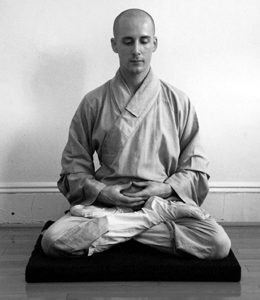Every time I teach children about lectio divina, I enjoy asking the same question. I ask them, “What do you think of when you hear the word ‘meditation’?” Inevitably, one or more kids cross their legs, put their hands in an Asian prayer position, and make the sound, “Om.” Although the number of actual practitioners of East Asian religions in the United States is relatively few, Asian philosophies and practice are having a huge impact on American society. Everything from Teavana and Starbucks to psychology and yoga should make us aware that ignoring such currents of thought could hamper our ability to evangelize.
In a recent thread of a forum dedicated to evangelization, a discussion took place on yoga in particular. What emerged from this discussion was a point of view that is common among Christians in America. The point of view that was proposed was that yoga and other forms of East Asian spiritual practices represent a dangerous part of the “New Age Movement” that could lead to opening of one’s self to demonic influence. Although not all participants agreed with this position, I think we should consider this viewpoint more carefully.
I think we should begin by making a few distinctions. First, we should recognize that there is a great difference between Hindu believers from India who are practicing meditation and yoga and Americans who are embracing these spiritual practices. In terms of the former, Hindu spirituality embraces a moral and spiritual norm which in many ways is similar and complementary to Christianity. It is such a foundation of virtuous living that the Catholic Church praised at the Second Vatican Council in the document Nostra Aetate. Such people would constitute honest spiritual seekers and their practices can be a powerful preparation to receive the fullness of truth in Jesus Christ. It seems difficult to argue that all Hindus in the world are under the influence of demonic forces, and the fact that Catholic leaders never make such statements should be informative.
In contrast, many Americans embrace such practices as an explicit means of rejecting Christianity. Although we do not want to jump to conclusions, many times among Americans practicing yoga and transcendental meditation there are many other elements which are not in accord with either Christian or Hindu morality. Sexual licentiousness, drug abuse, and other immoral practices are used alongside of them in a kind of pseudo-spirituality that seeks spiritual experience without moral living. Such a path is a recipe for all kinds of problems, the most extreme being demonic influence.
This does not mean, however, that yoga and transcendental meditation are intrinsically evil. Many studies done have shown that meditative practices can promote well-being, so there is a kind of natural wisdom contained within them. Such meditative practices constitute natural goods that can be either abused or used in accord with Divine providence. In the case of yoga, stretching and breathing are powerful biological forces that can help calm the mind and focus our drives. Furthermore, like all natural goods, such as our sexuality and the use of reason, they can be an opportunity for growth in virtue or a path to pride and enslavement to sin.
Ultimately, we must embrace interfaith dialogue with East Asian religions in the way that Christian’s have dialogued with other cultures for centuries. First, we must recognize the value and goodness of East Asian spiritualities as a kind of natural theology that should be respected. Next, we must acknowledge the ways that such a spirituality falls short of the glory offered in and through Jesus Christ. We must acknowledge that our purpose must be to facilitate intimacy with Jesus Christ, and thus we should embrace a form dialogue that is missionary in its orientation.
#yoga #transcendentalmeditation














I sent this letter to my 2 teenage grandchildren:
In the ‘60s and ‘70s, there was a wave of interest in Eastern religion and mysticism on college campuses. The Beatles had fallen under the sway of the Maharishi and his version of Eastern spirituality, which he called Transcendental Meditation. As a college student, I didn’t know much about Eastern thought, so when I heard that a weekend TM seminar was coming to town, I figured that it would be a quick and easy way to learn about Hindu philosophy. It cost me $75 to attend the seminar, which was a lot of money in those days (this should have set off a warning bell), and all I got out of it was a secret word. Currently, it costs $1500 to take a weekend TM seminar.
In the seminar, they start by telling you that TM is not religious, that it will fit in with any belief system. That is not quite true—TM does have a basis in Hinduism. However, TM is doctrinally quite different from the conventional Hinduism practiced by Hindus in India today. Traditional Hindus regard TM as a bastardization of their religion which the Maharishi cooked up in the 20th century.
The TM technique is simple. What TM’ers do is take out two 20-minute periods each day, close their eyes and relax in a sitting position, and mentally repeat their mantra over and over. However, in TM, you don’t concentrate on your mantra. You allow free rein to your thoughts. If your attention wanders, you just become aware of it and let it drift naturally back to your mantra.
How do you get your mantra? On Sunday morning (note the Christian Sabbath connection) of the seminar, there is a Hindu-like religious ceremony that everyone participates in. You bring a gift of flowers to your instructor, who is now dressed in a robe. You light incense while your instructor chants in a Sanskrit-sounding language around a statue of a Vedic god. At the conclusion of the ceremony, the instructor takes you into a private area, leans in very close to you, and whispers your secret word in your ear, i.e., your mantra.
You must never reveal your mantra to anyone. You can never find out the process by which the instructor knows that your mantra is the “right one” for you, and the subject of how mantras are determined in general is never to be revealed to anyone below the instructor level (although we now know that many of the TM mantras are names of Hindu gods). If you attempt to find out how they have figured out that your mantra is appropriate for you, you will be counseled not to be “anxious” about your mantra and instead to practice the TM technique “faithfully,” which will ultimately bring the fulfillment you are seeking.
In TM, there are higher teachings that are secret and can only be reached after years of hard work and study. I have actually seen a video of “advanced” TM followers who were sitting cross-legged in the lotus position in an ashram, occasionally “popping” themselves up into the air hoping that they would be able to levitate. Pathetic.